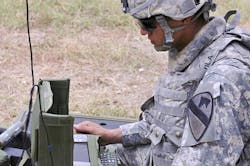Northrop Grumman begins production on remote-control unit for Spider anti-personnel grenades
Officials of the Army Contracting Command New Jersey at Picatinny Arsenal, N.J., announced a $13.4 million order Thursday to the Northrop Grumman Technology Services segment in Herndon, Va., for low-rate initial production of the Spider Increment I A remote-control unit.
Northrop Grumman is building an improved networked munitions control station for the XM-7 Spider anti-personnel networked munitions system that provides a secure remote command and control capability as far as 1500 meters for a hand-emplaced munition field.
The Spider system consists of as many as 60 munition control units (MCUs); a remote-control station (RCS); and a repeater for extending communication range. Each MCU can attach as many as six individual grenades -- each of which covers a 60-degree arc.
Related: Northrop Grumman picked to build improved control for networks of remote-fired grenades
Warfighters place The MCUs by hand, and an operator then can control six triplines to provide a sensing network. The operator control the network of grenades from as far away as one mile -- or farther with repeaters.
When a tripline is activated, the MCU connected to the line signals wirelessly to the operator, who can choose to fire one or more of the grenades. Operators also can turn off one, several, or all of the networked weapons in the munitions field.
Northrop Grumman engineers will retain the MCU, repeater, communications system, and other features of Spider Increment 1 to ensure backwards compatibility, and will include enhanced mapping capability; communications that link the munition field to the Army Battle Command System (ABCS); and the ability to employ existing munitions.
For more information contact Northrop Grumman Technology Services online at www.northropgrumman.com, or the Army Contracting Command New Jersey at http://acc.army.mil/contractingcenters/acc-nj.
Ready to make a purchase? Search the Military & Aerospace Electronics Buyer's Guide for companies, new products, press releases, and videos
